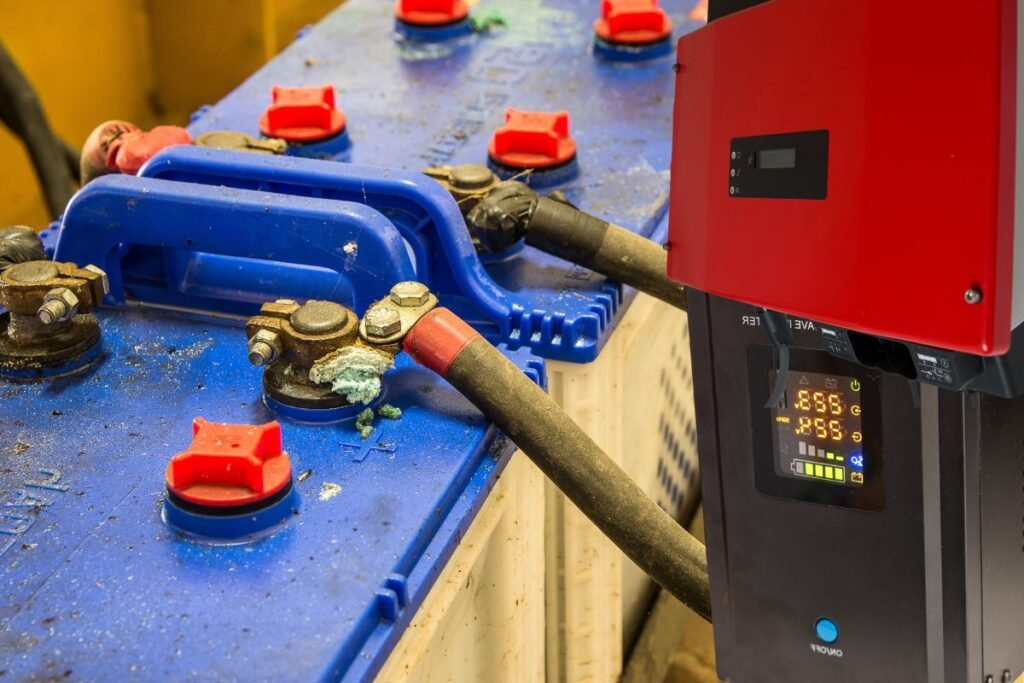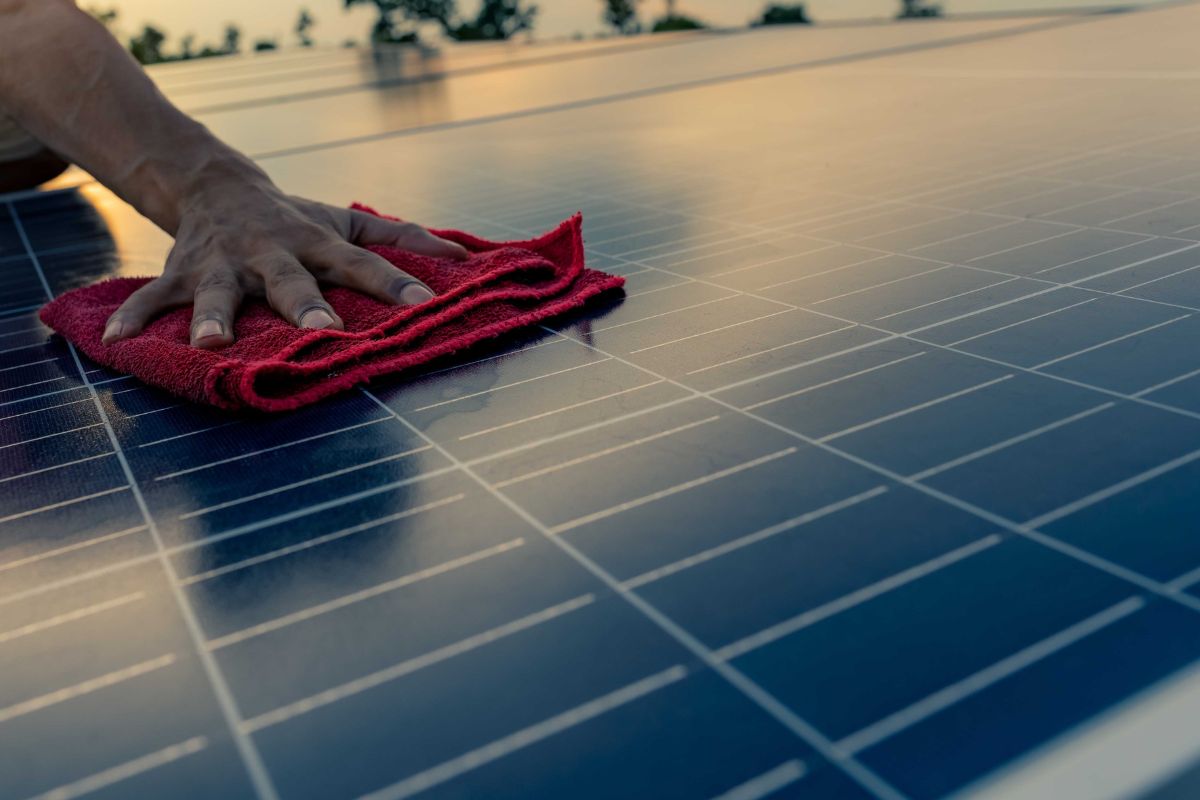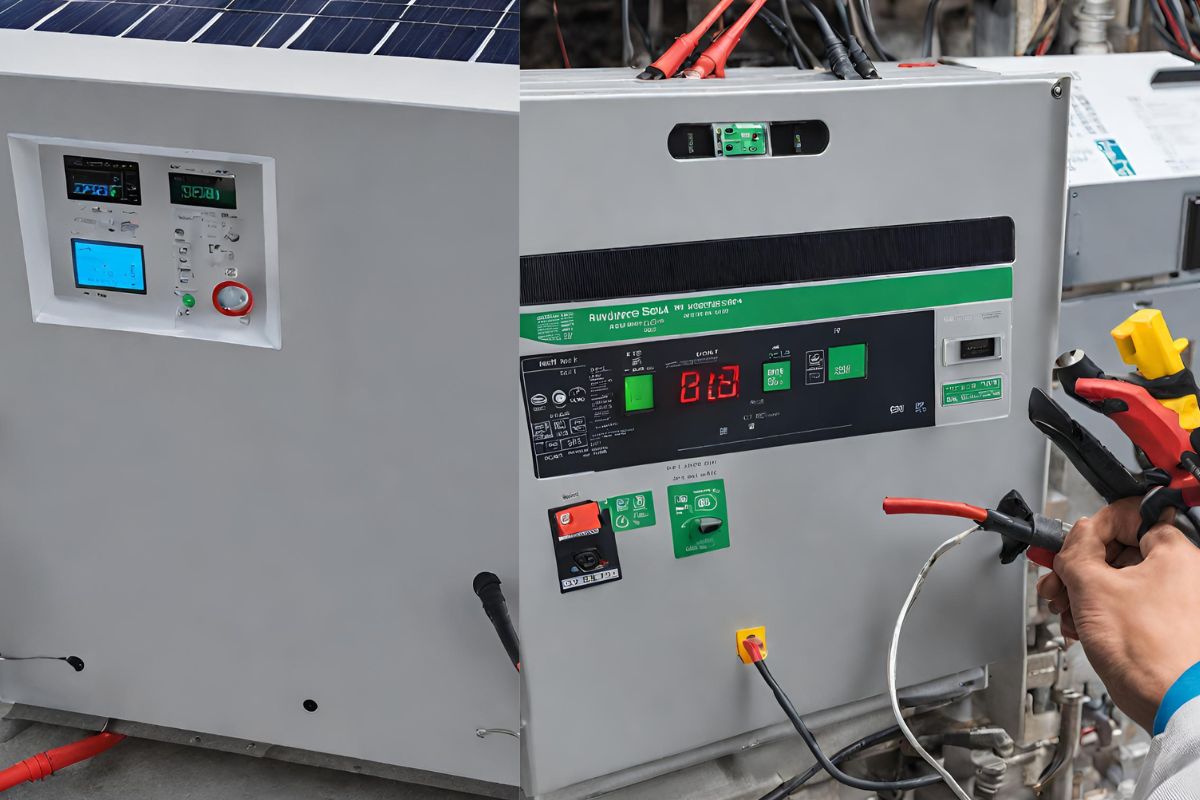Do you want to know how grid tie solar inverter with battery backup works? Or have you ever wondered how those rooftop solar panels keep the lights on even when the power fails?
In this post, let me show you how grid-tied solar inverters with battery backup work and other facts about it.
Let us get started.
How Does A Grid-Tied Solar Inverter With Battery Backup Work?
The way the grid-tied solar inverters with battery backup work is straightforward. For proper understanding, let me break them down as we read on.
- Understanding the ensemble
Consider a symphony in which the main panel serves as the conductor, directing electricity from the grid.
The AC disconnect is a gateway, directing electricity to the main performer—the SolarEdge inverter.
Like the lead violinist, this inverter takes center stage in coordinating the use of solar electricity.
To supplement this performance, more equipment is brought in. An autotransformer and a meter box serve as a communication gateway, monitoring and tracking the ebb and flow of electricity.
So, enter the backed-up load panel, a key component that ensures essential loads remain lighted even when the grid fails.
- Selecting the Right Notes
Not all loads are created equally. The problem is deciding which loads to include in the backup playlist, given a 5,000-watt cap during grid interruptions.
Lights, televisions, and refrigerators get seats, but power-hungry equipment like air conditioners may have to wait backstage.
- Navigating The Battery Ballet
The LG Chem battery, located between the storage inverter and the load panel, enhances performance.
With a limited stored capacity of around 10 kWh, it’s like having a gallon of water to satiate your energy needs.
However, much like sipping from a gallon, the more gadgets you have on standby, the faster the stored power drains.
- Balancing Act for Larger Loads
Maintaining creature comforts such as air conditioning and refrigerators has its issues.
Sacrifices may be required in the form of limiting other device usage. It’s a delicate balance, ensuring that the 5,000-watt inverter limit and the battery’s stored power are properly maintained.
Behind the scenes with the inverter and battery
A glance behind the curtain reveals the SolarEdge inverter’s terminals—a labyrinth of connections for the autotransformer, grid input, load panel output, battery link, and solar input.
Some models also have a digital display and buttons for on-site tinkering, eliminating the need for a phone or tablet.
- User-Friendly Performance
This symphony is easy to engage with. The inverter’s digital display and controls provide a hands-on experience, allowing users to program and monitor the system directly from the source.
For the tech-savvy, the latest SolarEdge inverters use the Set App for easy monitoring and configuration.
What Are The Key Components Of A Grid-Tied Solar Inverter With Battery Backup?
Absolutely, let’s look at the essential components of a grid-tied solar inverter with battery backup in a more human-readable perspective, taking inspiration from the offered text:
1. Solar Panels
Imagine solar panels as unsung heroes, poised on roofs and soaking up the sun’s beams.
These panels function as energy harvesters, transforming sunlight into the first spark of electricity.
2. Grid-Tied Solar Inverter
The grid-tied solar inverter is among the key components of a grid-tied solar inverter with battery backup.
Its role is to help convert the direct current from solar panels into alternating current to be used in our homes.
3. Battery Bank
Access the battery bank, the system’s treasure chest. It carefully retains extra energy created by the solar panels during the sunniest hours.
When clouds gather, or the grid goes down, the battery bank takes over to ensure a constant source of electricity.
4. Battery-Based Inverter
The battery-based inverter serves as a translator, turning the direct current power stored in batteries into the alternative current power required for home usage.
It works with the grid-tied inverter to provide a smooth flow, delivering electricity during both regular operation and grid interruptions.
5. Critical Loads Panel
Consider the important loads panel as the VIP section. It has circuits for essential equipment such as lights and refrigerators.
During a power outage, it guarantees that these critical loads receive precedence from the battery-powered inverter.
6. Optional AC Coupling
This system improves efficiency and connectivity. This requires a second battery-based inverter to provide a smooth connection between the grid-tied inverter and the critical load panel.
It’s similar to a backstage pass, boosting efficiency during normal operation and backup circumstances.
7. Main Panel and AC Disconnect
The main panel is the entrance point for grid power, allowing electricity into the system. The AC disconnect is ready to manage and halt the flow as needed, assuring safety during maintenance or unforeseen events.
8. Monitoring and Control System
A clever monitoring and control system takes over, closely checking the entire ensemble.
It allows customers to measure energy output, check battery levels, and verify that the grid-tied solar inverter with battery backup runs smoothly.
Each component uniquely contributes to creating a robust and sustainable energy solution for houses.
Together, they provide electricity and a consistent and dependable energy experience.
What Is The Purpose Of A Grid-Tied Solar Inverter With Battery Backup?
The purpose of a grid-tied solar inverter with battery backup is quite many, so let’s get to it:
1. Protecting Against Grid Hiccups
Have you ever had a power outage and hoped your important appliances wouldn’t stop working? That’s when the magic starts.
When the grid decides to play hide-and-seek, a grid-tied solar inverter with battery backup functions as a diligent guardian, keeping your lights on, the fridge running, and perhaps even your favorite program streaming.
2. The Movement of Power and Storage
At its core, this powerful pair (solar inverter and battery) converts your rooftop into a little power station. While the sun is out, the solar panels absorb its energy and transform it into power.
Now for the smart part. Instead of consuming it all at once, extra energy is stored in a battery, similar to conserving some sunshine for a rainy day.
3. Freedom from the 9-to-5 sun
The beauty is in the autonomy it provides. Do not be concerned as the sun goes down and your rooftop becomes black.
The battery kicks in, releasing stored energy to brighten your home.
It’s like having a hidden energy stockpile that keeps you comfortable even after the sun goes down for the day.
4. Navigating the Grid with Finesse
This structure is about cohabitation, not simply independence. During bright days, when your solar panels work overtime, the excess power is not squandered.
Instead, it flows seamlessly back into the grid, perhaps earning you credits or good karma for helping to create a more sustainable energy environment.
5. Embracing Sustainability One Kilowatt at a Time
Aside from the practicalities, there is a strong eco-conscious aura of receiving current from the sunlight and storing it for later use.
A grid-tied solar inverter with battery backup is about building a robust and green energy environment rather than just obtaining the sun’s rays.
Are Grid-Tied Solar Inverters With Battery Backup Suitable For Residential Use?
Yes, Grid-Tied Solar Inverters with Battery Backup are suitable for home use.
As you well know, these systems provide a dependable power source by seamlessly combining solar panels and a battery backup.
In the case of a grid outage, the battery provides uninterrupted power to key appliances, increasing comfort and convenience.
The capacity to store surplus solar energy enables electricity consumption during periods of low sunshine, providing autonomy and flexibility in energy utilization.
This residential-friendly technology provides a dependable backup and promotes a sustainable lifestyle by utilizing solar electricity.
Grid-Tied Solar Inverters with Battery backups are a practical and environmentally friendly alternative for home energy requirements since they also contribute surplus electricity to the grid on bright days.
How Do I Integrate A Battery Backup With A Grid-Tie Solar Power System?
Your grid-tied solar system with battery backup opens a realm of possibilities.
The integration process in response to a commonly asked question is simple as you follow the steps below:
- AC Coupling Unveiled
AC coupling is the preferred method for adding battery backup to an existing grid-tied solar system.
This involves introducing an additional battery-based inverter and a dedicated battery bank.
You can see the creation of a critical loads panel, acting as the nucleus for devices and appliances requiring power during grid outages.
- Configuration Overview
In an AC-coupled setup, a sub-panel is crafted to house critical loads. The output of the battery-based inverter is connected to this panel, along with the output of the existing grid-tied inverter.
This establishes a unified system where both inverters operate in tandem during normal grid conditions.
- Normal Operation
Under normal circumstances, solar panels generate power when the grid is active, feeding the grid-tied inverter.
This inverter covers loads on the critical panel, maintains the batteries, and redirects excess production to the mains load panel or even the grid, contributing to energy offset.
- Grid Outage Operation
When the grid falters, the system seamlessly transitions. The battery-based inverter, connected to the batteries, continues to produce power for the critical loads panel.
Importantly, it tricks the grid-tied inverter into thinking the grid is still operational, allowing solar panels to produce and cover critical loads, even during nighttime hours.
AC coupling is a reliable and intelligent method to integrate battery backup into your grid-tied solar system.
You can now understand how this configuration is done to ensure uninterrupted power, offering resilience and autonomy during grid outages.
Final Thought
Now that we have learned about the Grid tie solar inverter with battery backup and how they work.
You have noticed that this sophisticated system provides a backup option for critical loads during grid failures and enables consumers to participate in the symphony of sustainable energy.
Let the sun-powered music continue!
More Reads:



